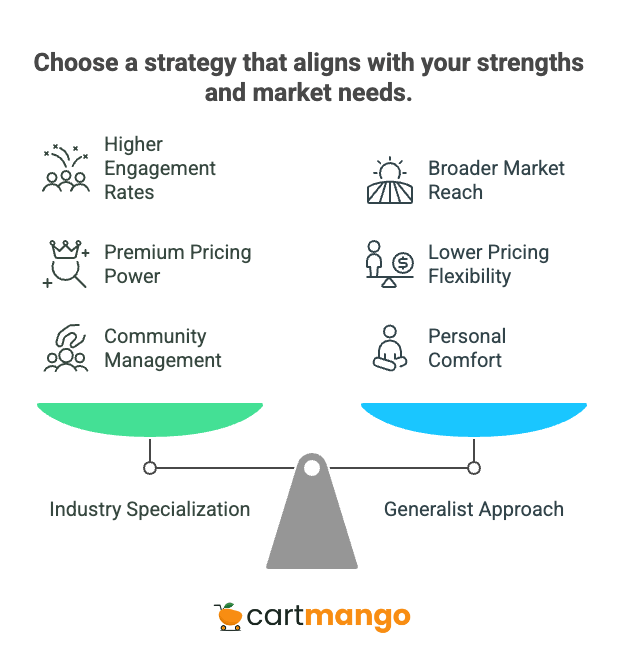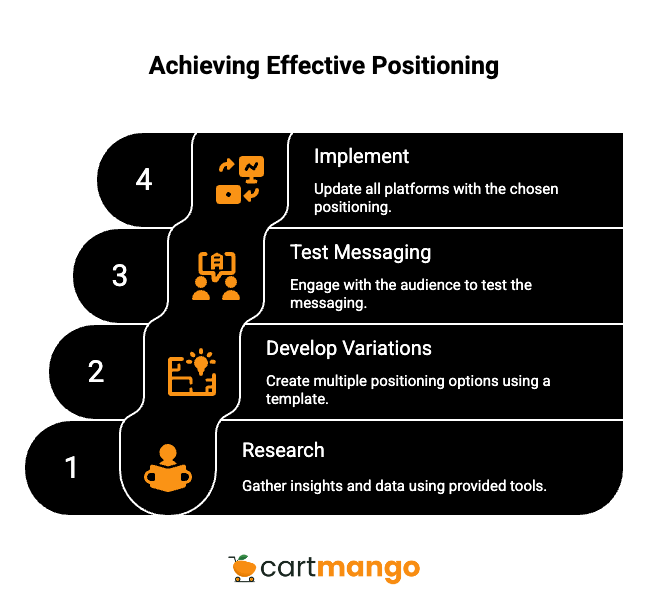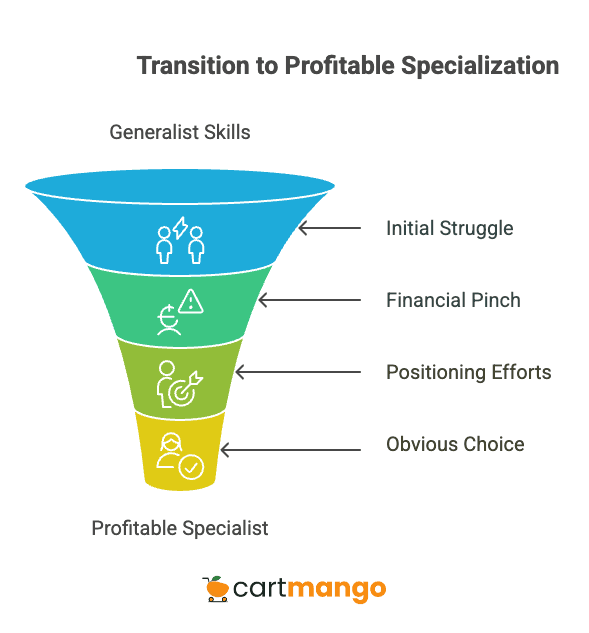Want to jump straight to The Positioning Statement Template? Go here.
–
Many solo professionals struggle with positioning because they try to appeal to everyone.
This guide offers a quick, actionable 24-hour framework to help independent course creators, digital sellers, and coaches/consultants find their niche…
So they can start attracting ideal clients immediately.
Niche-Positioning in 24 Hours
Hour 1-4: Quick Competitor Analysis
I’ve watched countless solo professionals burn themselves out trying to be everything to everyone. Don’t do that.
Start by scanning your competitors. Use Google and social media to see how others position themselves. Look for gaps or weaknesses you can fill.
Pay attention to the language your competitors use. Notice what they promise and what they avoid mentioning. Most importantly, look for what they’re NOT doing.
These gaps become your opportunities.
Hour 5-12: Find Your Micro-Niche
The “1,000 True Fans” concept by Kevin Kelly will save you from the exhausting chase of trying to please everyone. You just need a small, loyal audience who will pay premium prices for your expertise. Use free tools like Google Trends and Reddit to find specific sub-niches.
I recommend diving deep into one community rather than skimming across multiple markets. Your brain might be screaming “but what if I miss opportunities?”. Ignore that voice.
The money is in going narrow, not wide.
Start with a niche you already understand. If you’re a former teacher turned course creator, don’t try to serve all professionals. Focus on helping other teachers transition online. Your personal experience becomes your competitive advantage.
Hour 13-24: Message Testing and Validation

Craft a simple one-sentence positioning statement using this proven template. Test it on social media or with your existing audience. Use feedback to refine your message.
Positioning Statement Template:
For [specific target audience] who [specific problem/situation], [your name/brand] provides [specific solution/service] that [specific outcome/result] in [timeframe], because [unique differentiator/credibility].
- Target Audience: Be specific (burnt-out teachers, overwhelmed yoga studio owners)
- Problem/Situation: Current pain point they’re experiencing
- Solution: What you specifically offer
- Outcome: Measurable result they’ll achieve
- Timeframe: When they’ll see results
- Differentiator: Why you vs. competitors
Your positioning statement should make people either love you or completely ignore you. Lukewarm reactions mean you’re still too broad.
Here are 3 examples using the template:
For Course Creators:
“For burnt-out teachers who feel trapped in the classroom, TeacherTransition provides step-by-step online courses that guide you from resignation letter to profitable online educator in 90 days, because we’ve walked this exact path ourselves.”
For Digital Product Sellers:
“For overwhelmed yoga studio owners struggling with social media, YogaMarketingKit offers done-for-you templates and content calendars designed specifically for wellness businesses in under 30 minutes setup, because generic marketing advice doesn’t work for spiritual brands.”
For Coaches/Consultants:
“For tech startup founders drowning in operational chaos, StartupScale delivers systematic leadership coaching that turns scattered teams into high-performing organizations within 6 months, because we understand the unique pressures of scaling fast-growth companies.”
–
Notice how each example follows the formula. Test your statement with real people and watch their facial expressions.
Confusion means you need simpler language.
Industry-Specific Positioning Strategies
Different professional types need different approaches to stand out in crowded markets.
I’ve broken down strategies by profession type, complete with realistic pricing based on current market data.
Professional Type | Core Positioning Strategy | Pricing Approach | Offer Examples |
|---|---|---|---|
Course Creators | Niche-Specific Strategy | Mini course pricing ($47-$147) | Instagram Reels for Real Estate Agents |
Course Creators | Problem-Solution Strategy | Standard course pricing ($197-$497) | From Burnt Out Teacher to Online Educator |
Course Creators | Community-Driven Strategy | Course + membership hybrid | The Freelancer’s Business Course + Monthly Mastermind ($297 + $47/month) |
Digital Product Sellers | Template/Done-For-You Strategy | Value-based pricing ($27-$297) | 50 Canva Templates for Coaches, Pre-Written Email Sequences |
Digital Product Sellers | Niche-Specific Strategy | Market-rate pricing ($47-$147) | Yoga Studio Social Media Kit |
Digital Product Sellers | Bundle Strategy | Volume discount pricing ($97-$197) | The Complete Freelancer Toolkit |
Coaches/Consultants | Outcome-Focused Strategy | Results-based pricing ($1,500-$3,000) | 90-Day Revenue Breakthrough Program |
Coaches/Consultants | Industry Specialist Strategy | Premium specialist pricing ($2,000-$5,000) | Tech Startup Leadership Intensive |
Coaches/Consultants | Group Coaching Strategy | Accessible group pricing ($500-$1,500/month) | $100K Coach Collective |
- Course creators who focus on specific industries usually see higher engagement and completion rates.
- Digital product sellers who target narrow audiences can charge premium prices for specialized solutions.
- Coaches who position as industry specialists command fees that would make generalists weep with envy.
The key is matching your positioning strategy to your natural strengths and market demand. Don’t try to force a community-driven approach if you hate managing communities. Pick the strategy that feels most natural to your personality and working style.

Research Tools
You don’t need expensive software to nail your positioning. These (mostly free tools) will give you everything you need to research and validate your niche.
Research Category | Free Tool | Primary Use | Realistic Time Investment |
|---|---|---|---|
Niche Validation | Market demand trends | 30-45 mins | |
Competitor Analysis | Manual Google Search | Basic competitive landscape | 60-90 mins |
Audience Research | Pain point discovery | 2-3 hours | |
Survey Creation | SurveyMonkey (free plan) | Message testing (10 questions limit) | 30-45 mins |
Content Ideas | Question-based content | 20-30 mins | |
Social Listening | LinkedIn Search | Professional audience insights | 45-60 mins |
Keyword Research / Market Sizing | Suitable keywords, search volume estimates | 30-45 mins |
Start with Google Trends for quick market validation. The tool reveals whether your niche idea has staying power or if you’re chasing a fading trend. Then spend serious time in Facebook Groups for deeper audience research.
Facebook Groups are goldmines of unfiltered customer pain points. You’ll find people complaining about problems they’d pay good money to solve.
The secret is patience during the research phase. Most people rush through audience research because it feels boring. But those hours spent reading complaints and questions in Facebook Groups will inform every piece of content you create later.
7-Day Niche Positioning Strategy

- Day one through two should focus on research using the tools above. Your fingers will be tired from typing, and your eyes might burn from screen time, but push through.
- Days three and four are for developing three positioning variations using the template provided. You need multiple options because your first idea is rarely your best. Test each variation with the positioning statement template to ensure clarity.
- Days five and six involve testing messaging with your existing audience.
- Day seven is implementation day – update everything across all platforms.
The biggest mistake people make is perfectionism during the testing phase.
Your positioning doesn’t need to be perfect before you start using it. Better to test an imperfect message than to spend months crafting the “perfect” statement that never sees daylight.
Quick Wins Checklist

- Update your LinkedIn / social headline with your specific position. This single change can double your profile views overnight.
- Rewrite your bio focusing on one clear outcome.
- Create three pieces of positioned content.
- Test new pricing with your refined messaging.
These quick wins build momentum for bigger changes.
Also post consistently in your chosen niche’s Facebook groups or LinkedIn communities. Share helpful insights without pitching your services. The goal is to become a recognized name before you need to sell anything.
3 Common Mistakes
The “Shiny Object” Trap
I’ve seen professionals jump from niche to niche like they’re playing hopscotch. Chasing every new trend instead of deepening your position wastes time and money. Focus is your superpower in a distracted world.
The reality is sustained attention on one area creates compound results. Pick one positioning strategy and stick with it for at least six months before considering changes.
The “Too Narrow” Fear
Your inner voice screams that niching will limit your income. Perhaps you lie awake at night staring at the ceiling, worried about turning away potential clients. The fear feels real, but reality tells a different story.
Specialists consistently earn more than generalists. The riches truly are in the niches, even when your gut says otherwise.
Inconsistent Messaging
Your message must be consistent across all channels.
I see folks who sound like a business coach on LinkedIn but a life coach on Instagram. Mixed signals confuse potential clients and dilute your positioning power.
Create a simple document with your key positioning points and refer to it before writing any content. Consistency builds trust, and trust converts to sales.
Strengthening Your Position
Month 1-3: Foundation
Create content that reinforces your position.
Every blog post, social media update, and email should strengthen your niche authority. Build your network within your chosen niche rather than casting wide nets.
Client testimonials become your positioning proof. Collect them religiously and display them prominently. People believe other customers more than they believe your marketing claims.
The foundation phase requires discipline because results don’t appear immediately. You might feel like you’re talking to an empty room for the first few weeks. Just keep going.
Month 4-6: Authority Development
Seek speaking opportunities in your niche.
The stage gives you credibility that no amount of social media posting can match. Collaborate with others in your space rather than viewing them as competition.
Advanced Positioning: The Mass Niche Strategy
Once you’ve established your basic position, you can explore mass niche brand positioning – a strategic approach that combines the focus of a niche strategy with the growth potential of a broader market opportunity.
Mass niche positioning works by targeting a specific niche that offers massive growth potential.
Think of BMW positions itself with “the ultimate driving machine”. They focus on performance enthusiasts but appeal to the entire global car market. This is about creating a unique identity that resonates with a specific audience while attracting a broader audience.
Professional services firm examples also show this strategy in action. Take Quinn Emanuel, a litigation only law firm that positions itself exclusively as trial lawyers.
Here’s the clever part: very few significant disputes actually go to trial because most significant disputes end in settlements. But clients facing potentially expensive litigation want lawyers with trial experience. This mass niche approach gives them competitive edge in extremely crowded fields.
Here’s another example:
Enabling Apple to dominate isn’t just about technology – they’ve been overtly positioned as the brand for creative professionals while selling to everyone. Their niche brand identity creates increased customer loyalty across market segments. This creates a strong position in the marketplace that competitors struggle to match.
The key factors for successful niche positioning are:
- Deep understanding of your specific group
- Market leading expertise that attracts potential customers
- Strong brand identity that enables businesses to charge premium prices
- Tight strategic focus from your firm’s leadership team
This approach requires genuine determination because you’re essentially saying no to some opportunities to dominate the niche part of your market. Your market niche becomes more valuable as you build authority within it.
Monitoring and Refining Your Position
Your positioning isn’t set in stone.
Continuous refinement based on customer feedback and market research keeps you ahead of competitors.
Thorough market research means constantly checking what potential customers actually need. Analyze competitors regularly to spot gaps in their value proposition. Most professional services firm leaders skip this step after initial positioning, but markets change fast.
Customer loyalty comes from consistently delivering your unique value proposition across multiple touchpoints. Every interaction should reinforce your position.
Online communities where your specific audience gathers become goldmines for understanding evolving consumer needs.
Resource allocation becomes crucial as you grow. Focus your marketing efforts on channels where your niche market actually spends time. A west coast law firm specializing in tech startups shouldn’t waste money on traditional legal publications – they should be where startup founders are.
Continuously monitor these metrics:
- Market share within your niche market
- Customer loyalty rates compared to competitors
- Competitive market shifts that might affect your strategic advice
Different mass niche positionings require different monitoring approaches.
Targeted marketing campaigns work better when you track engagement from your specific niche versus the global market.
Your marketing strategy should evolve based on data, not assumptions. External consultants can help provide objective analysis of your brand identity and whether it still delivers significant benefit to your loyal customer base.
The biggest challenges in positioning come from trying to be everything to everyone. Stay focused on your specific group, and let your product or service quality speak for itself.
Your Turn

The path from struggling generalist to profitable specialist takes patience.
Your bank account might feel the pinch during the transition period, but the payoff comes when you become the obvious choice for your ideal clients.
Positioning isn’t about limiting yourself. It’s about becoming unmistakably valuable to the right people.
The riches are in the niches, and now you have the roadmap to claim yours.
Related
- SendOwl vs Gumroad: The Recurring Revenue Black Hole (2026)
- Gumroad vs Sellfy: The Vendor Lock-in Cage (2025)
- Gumroad vs Payhip: The Hidden Trap for Creators (2025)
- ThriveCart vs SamCart – The Subscription Hostage Trap (2025)
- 8 ThriveCart Alternatives & The Lifetime Pricing Paradox (2025)
- 8 SamCart alternatives + Subscription hostage (2025)
- The GENTLE Method: Soft marketing for creators
- How Far in Advance Should You Promote a Webinar?
- The SAVINGS Method: The Productivity Improvement Plan for Creators
- 9 Questions to Ask: How to Hire a Digital Marketing Agency
